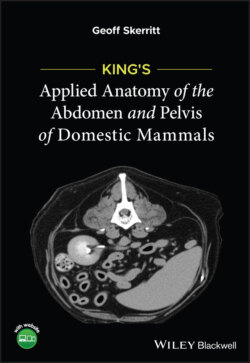Читать книгу King's Applied Anatomy of the Abdomen and Pelvis of Domestic Mammals - Geoff Skerritt - Страница 20
1.3.3 The rectus abdominis muscle (Figures 1.1 and 1.2)
ОглавлениеFigure 1.1 Lateral view of inguinal region of horse showing the rectus abdominis muscle. The peritoneum of the vaginal tunic is strongly reinforced by fusion with the internal spermatic fascia (derived from the transverse abdominal muscle).
Figure 1.2 Ventral view of the inguinal region of horse showing the rectus abdominis muscle. The left side of the diagram shows the relative positions of the superficial inguinal ring and the vaginal ring. On the right side of the diagram the vaginal tunic is shown wending its way from the deep inguinal ring, through the inguinal canal and out through the superficial inguinal ring.
Origin: The ventral surfaces of the sternal ribs and sternum.
Insertion: The cranial border of the pubis with the prepubic tendon. The prepubic tendon is the tendon of insertion of the two rectus abdominis muscles, although most of its fibres extend between the iliopubic eminences.
Structure: The left and right muscles are separated longitudinally by the linea alba, a band of fibrous tissue extending from the xiphoid cartilage to the prepubic tendon. A series of three to six transverse tendinous inscriptions cross each muscle belly, but the resulting muscle segments are not correlated with the nerve supply.
Species variations: In the ox there is wide separation of the medial borders of the rectus abdominis muscles. caudally. In the immature animal the linea alba is perforated by the umbilicus.
